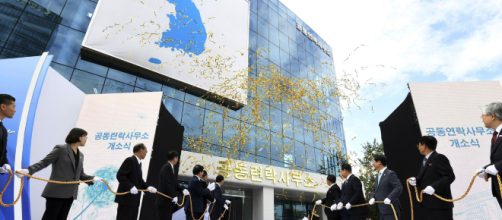North Korea has today withdrawn from the liaison office intended to provide continuing communications between the North and South. This follows failed talks between the US and North Korean leaders at a summit in Hanoi, Vietnam last month.
South Korea expressed its regret at the North’s decision to cease communicating through the office, which had been seen as a further sign of thawing relations between the two countries.
Before the centre was set up just across the border in North Korea, each side relied on fax machines and dedicated phone lines for communication.
These were often shut off at short notice in reaction to perceived threats or aggressive language.
The office was therefore designed to encourage a more steady flow of talks, with hopes of mutual benefit to each side. The timing of North Korea’s withdrawal seems significant. The Hanoi summit between President Trump and North Korean Leader Kim Jong-un followed another in June 2018 in Singapore, where talks also broke down.
Blame passed between US and North Korea
Kim Hyun-wook of the (South) Korean National Diplomatic Academy commented, “North Korea is putting South Korea on the spot to either make the US move or ignore sanctions and push forward with economic cooperation with them.”
Blame has been passed between the US and North Korea for failing to reach any solid agreements in the summits so far.
The US has stated that it wants Kim Jong-un to provide a detailed list of weapons and missile facilities. North Korea has stated this is too much to ask, and wants Trump to remove sanctions in recognition of North Korean efforts to de-nuclearise.
The US President walked out of the Hanoi summit after Kim insisted on a lifting of all sanctions. “I could have 100% signed something today. We actually had papers ready to be signed, but it just wasn’t appropriate. I’d much rather do it right than do it fast,” he said.
On the North Korean side, Deputy Foreign Minister Choe Son stated, “We have no intention to yield to the US demands in any form, nor are we willing to engage in negotiations of this kind.”
North Korea ‘no longer a threat’ according to Trump
After the first summit last year, President Trump spoke of North Korea's potential danger and stated it was “no longer a nuclear threat.” US Secretary of State Mike Pompeo recently appeared to renege somewhat on that view, declaring, “What [Trump] said was that the efforts that had been made in Singapore - this commitment that Chairman Kim made - have substantially taken down the risk to the American people.”
The summits have been met with great fanfare on both the American and North Korean sides, and closely watched by the international community for signs that any solid agreements could be made.
North and South Korea technically remain at war with each other. Those involved in peace talks since the Korean War started in 1950 have never been able to agree on terms. China, North Korea, and the UN Command led by the US would need to agree on a peace treaty for this to happen. An armistice was signed in 1953, but never a formal declaration that the war is over.
Earlier this month, US Secretary of State for Arms Control and International Security Andrea Thompson stated, “Is there a next summit? Well, I think there will be.”


